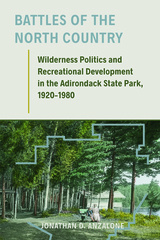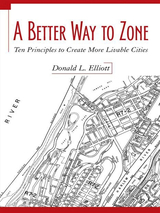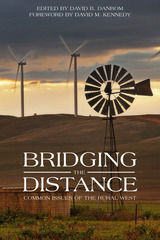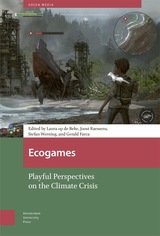121 books about Land use and 4
start with B
121 books about Land use and 4
121 books about Land use
4 start with B start with B
4 start with B start with B

Battles of the North Country
Wilderness Politics and Recreational Development in the Adirondack State Park, 1920-1980
Jonathan D. Anzalone
University of Massachusetts Press, 2018
The Adirondack region is trapped in a cycle of conflict. Nature lovers advocate for the preservation of wilderness, while sports enthusiasts demand infrastructure for recreation. Local residents seek economic opportunities, while environmentalists fight industrial or real estate growth. These clashes have played out over the course of the twentieth century and continue into the twenty-first.
Through a series of case studies, historian Jonathan D. Anzalone highlights the role of public and private interests in the region and shows how partnerships frayed and realigned in the course of several key developments: the rise of camping in the 1920s and 1930s; the 1932 Lake Placid Olympics; the construction of a highway to the top of Whiteface Mountain; the postwar rise of downhill skiing; the completion of I-87 and the resulting demand for second homes; and the 1980 Lake Placid Olympics. Battles of the North Country reveals how class, economic self-interest, state power, and a wide range of environmental concerns have shaped modern politics in the Adirondacks and beyond.
Through a series of case studies, historian Jonathan D. Anzalone highlights the role of public and private interests in the region and shows how partnerships frayed and realigned in the course of several key developments: the rise of camping in the 1920s and 1930s; the 1932 Lake Placid Olympics; the construction of a highway to the top of Whiteface Mountain; the postwar rise of downhill skiing; the completion of I-87 and the resulting demand for second homes; and the 1980 Lake Placid Olympics. Battles of the North Country reveals how class, economic self-interest, state power, and a wide range of environmental concerns have shaped modern politics in the Adirondacks and beyond.
[more]

A Better Way to Zone
Ten Principles to Create More Livable Cities
Donald L. Elliott
Island Press, 2008
Nearly all large American cities rely on zoning to regulate land use. According to Donald L. Elliott, however, zoning often discourages the very development that bigger cities need and want. In fact, Elliott thinks that zoning has become so complex that it is often dysfunctional and in desperate need of an overhaul. A Better Way to Zone explains precisely what has gone wrong and how it can be fixed.
A Better Way to Zone explores the constitutional and legal framework of zoning, its evolution over the course of the twentieth century, the reasons behind major reform efforts of the past, and the adverse impacts of most current city zoning systems. To unravel what has gone wrong, Elliott identifies several assumptions behind early zoning that no longer hold true, four new land use drivers that have emerged since zoning began, and basic elements of good urban governance that are violated by prevailing forms of zoning. With insight and clarity, Elliott then identifies ten sound principles for change that would avoid these mistakes, produce more livable cities, and make zoning simpler to understand and use. He also proposes five practical steps to get started on the road to zoning reform.
While recent discussion of zoning has focused on how cities should look, A Better Way to Zone does not follow that trend. Although New Urbanist tools, form-based zoning, and the SmartCode are making headlines both within and outside the planning profession, Elliott believes that each has limitations as a general approach to big city zoning. While all three trends include innovations that the profession badly needs, they are sometimes misapplied to situations where they do not work well. In contrast, A Better Way to Zone provides a vision of the future of zoning that is not tied to a particular picture of how cities should look, but is instead based on how cities should operate.
A Better Way to Zone explores the constitutional and legal framework of zoning, its evolution over the course of the twentieth century, the reasons behind major reform efforts of the past, and the adverse impacts of most current city zoning systems. To unravel what has gone wrong, Elliott identifies several assumptions behind early zoning that no longer hold true, four new land use drivers that have emerged since zoning began, and basic elements of good urban governance that are violated by prevailing forms of zoning. With insight and clarity, Elliott then identifies ten sound principles for change that would avoid these mistakes, produce more livable cities, and make zoning simpler to understand and use. He also proposes five practical steps to get started on the road to zoning reform.
While recent discussion of zoning has focused on how cities should look, A Better Way to Zone does not follow that trend. Although New Urbanist tools, form-based zoning, and the SmartCode are making headlines both within and outside the planning profession, Elliott believes that each has limitations as a general approach to big city zoning. While all three trends include innovations that the profession badly needs, they are sometimes misapplied to situations where they do not work well. In contrast, A Better Way to Zone provides a vision of the future of zoning that is not tied to a particular picture of how cities should look, but is instead based on how cities should operate.
[more]

Bridging the Distance
Common Issues of the Rural West
David B. Danbom
University of Utah Press, 2015
Bridging the Distance examines a number of the problems and prospects of the rural West that have largely been neglected by scholars. The issues are considered in four sections—Defining the Rural West, Community, Economy, and Land Use—each with an introduction by editor David Danbom. The essays highlight factors that set the region apart from the rest of the country and provide varied perspectives on challenges faced by those living in often isolated areas. Contributors cover matters such as a hazing incident that divided a small Colorado town and the effects of media coverage; challenges in areas of Montana and Wyoming where the ideas of new exurbanites regarding natural resources differ from those of long-time residents; conflict between surface water and ground water users in Colorado, Kansas, and Nebraska; and the shortcomings of health care among Latino immigrants in rural California. Essays on rural economy suggest how states can better use fiscal policies to advance long-term economic health and how resources can be exploited in ways that are both environmentally and economically sustainable. On the question of land use, one essay shares the viewpoint of a ranching family in Nevada that has long struggled with the government over grazing cattle on federal lands. Another examines the case of the Goshute Indians of Skull Valley, whose efforts to use their reservation for nuclear waste storage roused the ire of the state of Utah.
The essays in Bridging the Distance are fresh, informative, and insightful examinations of the complex problems facing the rural West. This is a book that will spur both conversations and the search for solutions.
The essays in Bridging the Distance are fresh, informative, and insightful examinations of the complex problems facing the rural West. This is a book that will spur both conversations and the search for solutions.
[more]

Bureaucrats, Clients, and Geography
The Bailly Nuclear Power Plant Battle in Northern Indiana
Nancy J. Obermeyer
University of Chicago Press, 1989
READERS
Browse our collection.
PUBLISHERS
See BiblioVault's publisher services.
STUDENT SERVICES
Files for college accessibility offices.
UChicago Accessibility Resources
home | accessibility | search | about | contact us
BiblioVault ® 2001 - 2024
The University of Chicago Press









